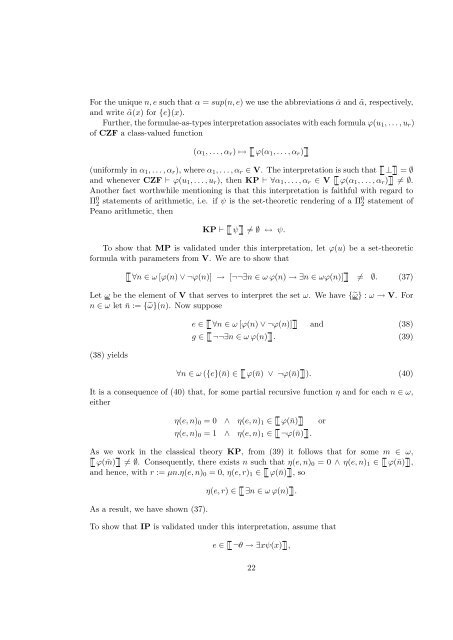Realizability for Constructive Zermelo-Fraenkel Set Theory
Realizability for Constructive Zermelo-Fraenkel Set Theory
Realizability for Constructive Zermelo-Fraenkel Set Theory
Create successful ePaper yourself
Turn your PDF publications into a flip-book with our unique Google optimized e-Paper software.
For the unique n, e such that α = sup(n, e) we use the abbreviations ᾱ and ˜α, respectively,and write ˜α(x) <strong>for</strong> {e}(x).Further, the <strong>for</strong>mulae-as-types interpretation associates with each <strong>for</strong>mula ϕ(u 1 , . . . , u r )of CZF a class-valued function(α 1 , . . . , α r ) ↦→ ‖ ϕ(α 1 , . . . , α r ) ‖(uni<strong>for</strong>mly in α 1 , . . . , α r ), where α 1 , . . . , α r ∈ V. The interpretation is such that ‖ ⊥ ‖ = ∅and whenever CZF ⊢ ϕ(u 1 , . . . , u r ), then KP ⊢ ∀α 1 , . . . , α r ∈ V ‖ ϕ(α 1 , . . . , α r ) ‖ ≠ ∅.Another fact worthwhile mentioning is that this interpretation is faithful with regard toΠ 0 2 statements of arithmetic, i.e. if ψ is the set-theoretic rendering of a Π0 2 statement ofPeano arithmetic, thenKP ⊢ ‖ ψ ‖ ≠ ∅ ↔ ψ.To show that MP is validated under this interpretation, let ϕ(u) be a set-theoretic<strong>for</strong>mula with parameters from V. We are to show that‖ ∀n ∈ ω [ϕ(n) ∨ ¬ϕ(n)] → [¬¬∃n ∈ ω ϕ(n) → ∃n ∈ ωϕ(n)] ‖ ≠ ∅. (37)Let ω be the element of V that serves to interpret the set ω. We have {˜ω} : ω → V. Forn ∈ ω let ¯n := {˜ω}(n). Now suppose(38) yieldse ∈ ‖ ∀n ∈ ω [ϕ(n) ∨ ¬ϕ(n)] ‖ and (38)g ∈ ‖ ¬¬∃n ∈ ω ϕ(n) ‖. (39)∀n ∈ ω ({e}(¯n) ∈ ‖ ϕ(¯n) ∨ ¬ϕ(¯n) ‖). (40)It is a consequence of (40) that, <strong>for</strong> some partial recursive function η and <strong>for</strong> each n ∈ ω,eitherη(e, n) 0 = 0 ∧ η(e, n) 1 ∈ ‖ ϕ(¯n) ‖ orη(e, n) 0 = 1 ∧ η(e, n) 1 ∈ ‖ ¬ϕ(¯n) ‖.As we work in the classical theory KP, from (39) it follows that <strong>for</strong> some m ∈ ω,‖ ϕ( ¯m) ‖ ≠ ∅. Consequently, there exists n such that η(e, n) 0 = 0 ∧ η(e, n) 1 ∈ ‖ ϕ(¯n) ‖,and hence, with r := µn.η(e, n) 0 = 0, η(e, r) 1 ∈ ‖ ϕ(¯n) ‖, soAs a result, we have shown (37).η(e, r) ∈ ‖ ∃n ∈ ω ϕ(n) ‖.To show that IP is validated under this interpretation, assume thate ∈ ‖ ¬θ → ∃xψ(x) ‖,22
















